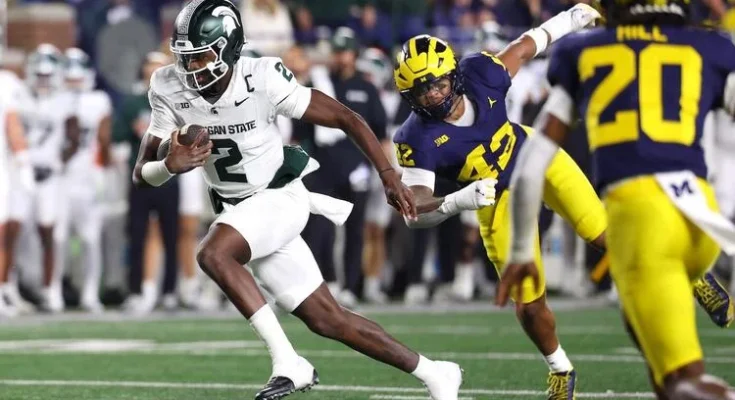“College Football’s Fear Factor: Worst‑Case Catastrophes Await the Preseason Top‑25 Teams in 2025”
With the 2025 college football season on the horizon, anticipation and optimism run high for the top‑25 programs. Yet, beneath the hype lurk very real threats—worst‑case scenarios that could derail the most promising seasons. From offensive line breakdowns to quarterback instability and portal pitfalls, here’s a deeper dive into what could go wrong for several high‑profile teams if the deck of cards collapses.
Picture Texas, riding high with expectations and a schedule war‑painted in bold. Their offensive line, though talented in parts, is a complete rebuild after losing four starters to the NFL draft. Facing Ohio State in Week 1 only amplifies the pressure—and if that line falters, quarterback Arch Manning could be exposed early, sparking a domino effect that ends in an alarming 8‑4 collapse and tumble out of the Top 25.
Then there’s Georgia, the SEC powerhouse with a history of reliability. Their worst‑case scenario stems from losing six veteran front‑seven defensive contributors, including top edge rushers who engineered relentless pressure in 2024. If replacements like Gabe Harris Jr. and Army transfer Elo Modozie fail to fill the void, the Bulldogs could suddenly lose their identity—stuck in the muck of a “what if” season.
Ohio State’s nightmare is stark as well. Will Howard, their dynamic quarterback, is now in the NFL—losing his elite 97.2 QBR in the playoff makes life uncertain. Whether it’s Julian Sayin or Lincoln Kienholz taking over, any missteps behind center could scatter the Buckeyes’ playoff hopes, undermining what once seemed like assured dominance.
LSU too is edging toward a potential freefall. The Tigers lost one of the best tackle duos in college football, now scattered in NFL pursuits. Replacements exist, but without cohesion up front or protection for Garrett Nussmeier, the season could snowball to a concerning 6‑6 record—a level of mediocrity that could cost Brian Kelly dearly.
Notre Dame addresses a more nuanced weakness—tight ends. A historic position of strength, it’s now in question. Eli Raridon battles injury history, while Cooper Flanagan’s availability is uncertain after an Achilles tear. A receiving corps already thin outside wideouts means offense could stall if the tight end role falters again.
Oregon’s defensive line rotations also carry risk. After losing Derrick Harmon, Jordan Burch, and Jamaree Caldwell, the Ducks are building from scratch—relying on newcomers like Bear Alexander from USC and rising sophomores like Aydin Breland. If they don’t gel quickly, an unsteady front could translate into catastrophic breakdowns late in the season.
Even Alabama isn’t immune. Despite SEC dominance, their pass rush ranks just 13th in the conference. With no marquee edge rusher to replicate the impact of Will Anderson Jr. or Dallas Turner, the Crimson Tide might find themselves outpaced in big games, setting up a rare underachievement.
BYU’s worst‑case resides in quarterback uncertainty. With Jake Retzlaff expected to transfer, the cupboard is bare. McCae Hillstead, Treyson Bourguet, and freshman Bear Bachmeier vie for the job—but no clear starter exists. If the pick falters, offensive chaos could ensue.
In the SEC, Florida faces an uphill battle. Their slate includes road trips to LSU and Miami, followed by a home game against Texas, and a grueling November reggae of Georgia, Ole Miss, and Tennessee. If the Gators lose both September road games, hopes plummet—destined for a 6‑6 collapse and unlikely playoff invite.
Georgia, ever the model of consistency, also carries a fragile blade. Worst‑case? A shocking 8‑4 season. Five ranked opponents, tough road tests, and an inconsistent offense could combine to inflict an uncharacteristic regression on Kirby Smart’s program.
Texas A&M—seasoned with promise—is another one to watch. Without improvement from opponents, the Aggies’ schedule could leave them stranded at 5‑7, falling out of bowl eligibility if key road tests at Notre Dame, LSU or Texas slip away.
Looking outside the SEC, in the Big Ten, Penn State’s worst‑case remains eerily plausible. A home loss to Oregon might not ignite alarm, but a subsequent upset at UCLA and a road defeat to Ohio State could swiftly unravel playoff dreams, ending in a deflating 9‑3 finish—and mounting pressure on James Franklin’s job security.
UCLA too could slide into oblivion. Their best-case scenario posits a confident breakout by Nico Iamaleava and upset wins over Utah, Washington, and USC. But if that doesn’t materialize? A disastrous 2‑10 collapse awaits, revealing regression rather than growth and dampening the program’s trajectory.
USC’s ceiling glimmers with potential—an 11‑1 return to prominence under Lincoln Riley. But without immediate availability of receivers and offensive line cohesion, the Trojans’ early-season momentum could vanish. A four‑game skid later in the year could trigger a 5‑7 wreckage and pressure Riley’s seat heating up.
In the ACC, Miami expects a breakthrough. A healthy Carson Beck and upgraded defense could thrust them into playoff contention. Yet, even then their floor sits at 8‑4. If execution falters against Notre Dame or SMU—or Beck’s health fails—the Hurricanes could fall short on promise and produce a largely unsatisfying record.
Across the landscape, the worst‑case threads are remarkably similar—key departures, fragile positions, and unforgiving schedules. For every marquee team mentioned, the fragility is there—Texas without a proven offensive line, Georgia without elite pass rush, Ohio State with a rookie QB, LSU lacking line cohesion, Florida facing brutal travel windows, USC’s slips in seeding, and Miami’s dependence on health and consistency. While the face of college football pessimism is never part of the preseason narrative, these scenarios demand attention—because they remind us that top‑25 status means little when the pieces fail to align.
As fans and analysts prepare for kickoff, it’s equally important to price these risks into expectations. Far too often, the shock of collapse blinds communities midseason. This countdown to disaster—or triumph—makes the coming months compelling, unpredictable, and exquisitely fragile.
In a nutshell, these worst‑case visions are not about prediction—they’re cautionary tales. They demand respect—coaching finesse, execution excellence, depth management, and a little luck. Without them, the top‑25 could quickly become the “should‑have‑been‑top‑50.”



